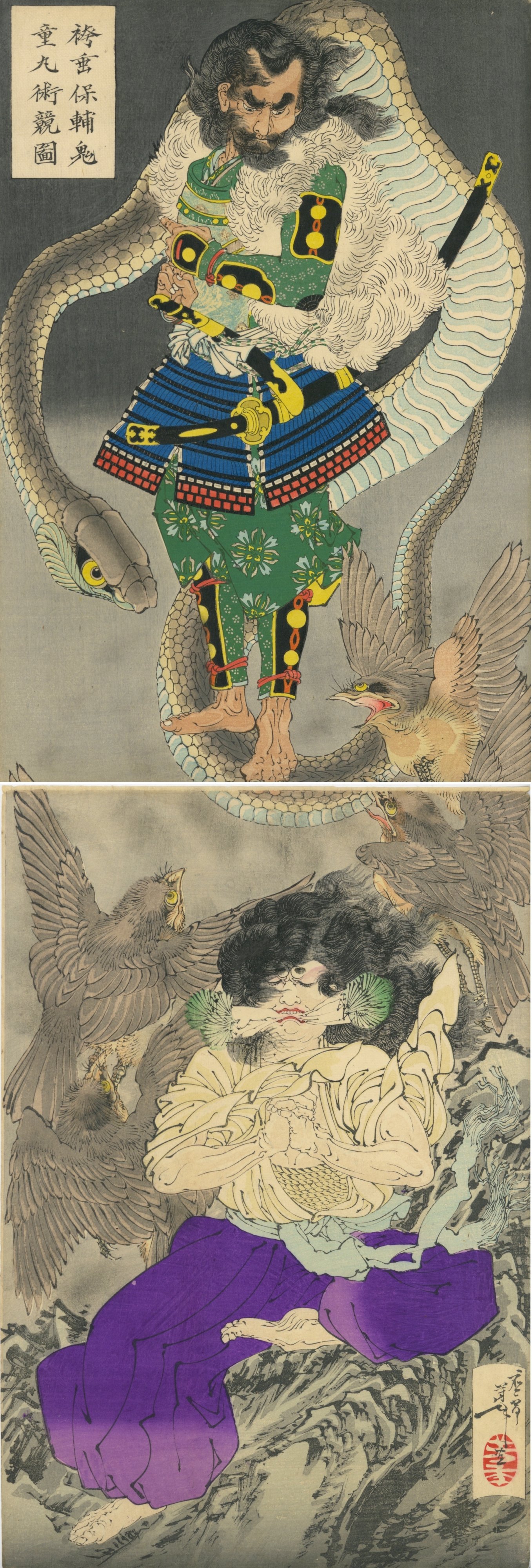Yoshitoshi | Hakamadare Yasusuke and Kidomaru Fighting with Magic
月岡芳年 Tsukioka Yoshitoshi(1839–1892)
袴垂保輔鬼童丸術競図
Hakamadare Yasusuke and Kidomaru Fighting with Magic
1887
木版画 | 双联续绘-纵绘大判 | 70cm x 25cm
Woodblock-print | Diptych-Oban-tate-e | 70cm x 25cm
颜色鲜艳;早期版次;经修剪;有托底
Very good color; early impression; trimmed; backed
“胆子大、腕力强、腿脚快、手段高、头脑灵,世上独一无二之人物。”以上所言,乃是古书对日本传说中的大盗贼袴垂保辅的形象描述。其原型应为平安时代中期著名贵族藤原保昌之弟藤原保辅。他曾为官员,但性情乖劣,仗着一身本事屡次犯罪,而后更是拉帮结派四处打家劫舍。当最终被官府抓获时,他直接拔出刀十字切腹,扯肠自杀,故被认为是日本史上切腹自尽第一人。既有如此神异人物,后世传奇自是数不胜数。江户时代著名作家曲亭马琴(1767-1848)的《四天王剿盗异录》中,就记叙有袴垂保辅与鬼童丸斗法的章节。这也正是本作的灵感来源。话说这么一日,两者在山中洞窟相遇。作为老牌狠角色,狡猾暴烈的妖人鬼童丸对同为大盗,又同会使召唤术的袴垂保辅颇具挑衅之意,顷刻间剑拔弩张。画面中,鬼童丸眉头紧锁,面目狰狞,口咬符纸,双手掐诀,呈半跏趺坐于怪石之上。身外召唤出的几只恶鸟盘旋起罡风,金眼阔口,皆欲冲向上方的袴垂与巨蛇,准备一决死战;一身典型武家装扮的袴垂保辅则凌腾半空,眉头紧锁,看似正与巨蛇作防守之势,实则早已捻诀在手,一触即发。芳年笔触细腻,线条精准,斗法竞术,尽跃纸上,不愧为其后期佳作之一。
Interested in purchasing?
Please contact us.
月岡芳年 Tsukioka Yoshitoshi(1839–1892)
袴垂保輔鬼童丸術競図
Hakamadare Yasusuke and Kidomaru Fighting with Magic
1887
木版画 | 双联续绘-纵绘大判 | 70cm x 25cm
Woodblock-print | Diptych-Oban-tate-e | 70cm x 25cm
颜色鲜艳;早期版次;经修剪;有托底
Very good color; early impression; trimmed; backed
“胆子大、腕力强、腿脚快、手段高、头脑灵,世上独一无二之人物。”以上所言,乃是古书对日本传说中的大盗贼袴垂保辅的形象描述。其原型应为平安时代中期著名贵族藤原保昌之弟藤原保辅。他曾为官员,但性情乖劣,仗着一身本事屡次犯罪,而后更是拉帮结派四处打家劫舍。当最终被官府抓获时,他直接拔出刀十字切腹,扯肠自杀,故被认为是日本史上切腹自尽第一人。既有如此神异人物,后世传奇自是数不胜数。江户时代著名作家曲亭马琴(1767-1848)的《四天王剿盗异录》中,就记叙有袴垂保辅与鬼童丸斗法的章节。这也正是本作的灵感来源。话说这么一日,两者在山中洞窟相遇。作为老牌狠角色,狡猾暴烈的妖人鬼童丸对同为大盗,又同会使召唤术的袴垂保辅颇具挑衅之意,顷刻间剑拔弩张。画面中,鬼童丸眉头紧锁,面目狰狞,口咬符纸,双手掐诀,呈半跏趺坐于怪石之上。身外召唤出的几只恶鸟盘旋起罡风,金眼阔口,皆欲冲向上方的袴垂与巨蛇,准备一决死战;一身典型武家装扮的袴垂保辅则凌腾半空,眉头紧锁,看似正与巨蛇作防守之势,实则早已捻诀在手,一触即发。芳年笔触细腻,线条精准,斗法竞术,尽跃纸上,不愧为其后期佳作之一。
Interested in purchasing?
Please contact us.
月岡芳年 Tsukioka Yoshitoshi(1839–1892)
袴垂保輔鬼童丸術競図
Hakamadare Yasusuke and Kidomaru Fighting with Magic
1887
木版画 | 双联续绘-纵绘大判 | 70cm x 25cm
Woodblock-print | Diptych-Oban-tate-e | 70cm x 25cm
颜色鲜艳;早期版次;经修剪;有托底
Very good color; early impression; trimmed; backed
“胆子大、腕力强、腿脚快、手段高、头脑灵,世上独一无二之人物。”以上所言,乃是古书对日本传说中的大盗贼袴垂保辅的形象描述。其原型应为平安时代中期著名贵族藤原保昌之弟藤原保辅。他曾为官员,但性情乖劣,仗着一身本事屡次犯罪,而后更是拉帮结派四处打家劫舍。当最终被官府抓获时,他直接拔出刀十字切腹,扯肠自杀,故被认为是日本史上切腹自尽第一人。既有如此神异人物,后世传奇自是数不胜数。江户时代著名作家曲亭马琴(1767-1848)的《四天王剿盗异录》中,就记叙有袴垂保辅与鬼童丸斗法的章节。这也正是本作的灵感来源。话说这么一日,两者在山中洞窟相遇。作为老牌狠角色,狡猾暴烈的妖人鬼童丸对同为大盗,又同会使召唤术的袴垂保辅颇具挑衅之意,顷刻间剑拔弩张。画面中,鬼童丸眉头紧锁,面目狰狞,口咬符纸,双手掐诀,呈半跏趺坐于怪石之上。身外召唤出的几只恶鸟盘旋起罡风,金眼阔口,皆欲冲向上方的袴垂与巨蛇,准备一决死战;一身典型武家装扮的袴垂保辅则凌腾半空,眉头紧锁,看似正与巨蛇作防守之势,实则早已捻诀在手,一触即发。芳年笔触细腻,线条精准,斗法竞术,尽跃纸上,不愧为其后期佳作之一。
Interested in purchasing?
Please contact us.
Tsukioka Yoshitoshi (1839–1892)
Tsukioka Yoshitoshi may have lived for only 53 years, a short lifespan even in Edo times, but the history he witnessed and the myriad styles he embraced could have easily filled twice that many decades. Beginning as a more-or-less classic Ukiyo-e artist of the Utagawa school, in the waning days of the Shogunate, he developed a style that was both in-sync with Western styles and utterly his own. He was there as Japan metamorphized from a feudal land to a nascent modern society, and he managed to capture that elusive moment in time in more than 2000 woodblock prints for more than 50 publishers.
You could say he was the last great Ukiyo-e artist, and perhaps the first great post-Ukiyo-e artist. His fantastical designs ranged from history – often with buckets of blood – to bijin (beautiful women) to landscapes. He depicted people from a variety of angles and gave them intricate, and often grotesque, facial characteristics, a far cry from the simple, stereotypical visages common to Japanese woodblock prints. And he could have fun. One of his last great series, 1888’s “32 Aspects of Women,” humorously shows women through various realms of Japanese culture, and depicts very specifics moods and sensations – for example, “Cool,” “Thirsty” and “Itchy.” My favorite? “Disagreeable: Habits of a young woman of Nagoya in the Ansei era.” Ha! What a pill she looks like.
Yoshitoshi was born into a merchant family in 1839. He was an early student of Kuniyoshi, who gave him his name. Many of his warrior designs, especially the earlier ones, show a clear debt to the master, with all manner of high energy action filling his oban-size prints. He became known as a “war artist” specializing in bloody designs in the 1860s. He did numerous warrior, folklore and history series’ during this period.
But those were not his only genres. He also contributed to the epic “Processional Tokaido,” in which most of the great Ukiyo-e artists and publishers of the time combined forces to depict the Shogun’s journey to Kyoto to pay respects to the Emperor, and did his share of “Yokohama-e,” prints depicting the newly arrived Westerners.
His creativity was evident here, as he even went so far as to imagine what one of the foreign countries, France, looked like in one 1866 print. (This is one of my favorites in XZ Ukiyoe’s collection.)
He was tormented by a mysterious mental disorder – some say that’s what sparked such a violent imagination – and had numerous marriages and amorous affairs. He stopped working for a period, and when he came back called himself Taiso – resurrection. By the 1880’s his talent reached it’s zenith, with his epic “100 Aspects of the Moon,” and other series. His drawings and color schemes became more elaborate and more, well, his. They switched easily between bold and blunt and delicate and sensitive (and back again). Still suffering from mental illness, he died in 1892.
Partial citation: Marks, Andreas, Japanese Woodblock Prints, Artists, Publishers and Masterworks (Tuttle; 2010).




